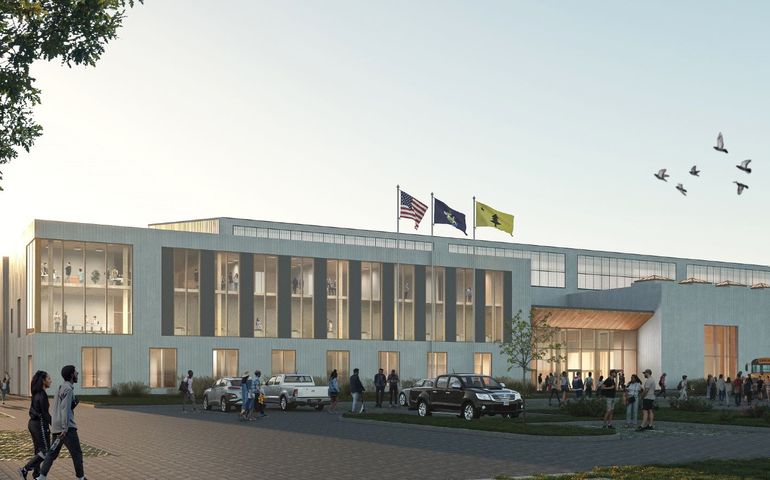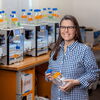
UMaine plans $75M ‘factory of the future’ for high-tech bio-manufacturing
 Courtesy / University of Maine
Seen here is a concept rendering of a proposed building that will house a “factory of the future” research lab.
Courtesy / University of Maine
Seen here is a concept rendering of a proposed building that will house a “factory of the future” research lab.
The University of Maine has plans in the works to expand its Advanced Structures and Composites Center in Orono, with an eye toward advancing research into large-scale, bio-based additive manufacturing that uses artificial intelligence and arrays of huge 3D printers.
The university calls the new facility the “factory of the future.” On Tuesday, the U.S. Senate Appropriations Committee voted to fund $35 million this fiscal year for the expansion, representing about half its projected cost. The center's new capabilities could drive new technology development in industries such as affordable housing, clean energy, construction, transportation, boatbuilding and furniture.
The bills must still be voted on by the full Senate and House and would require a signature from the president.
“This is something we’ve been working on a number of years and building up to,” said Habib Dagher, executive director of the Advanced Structures and Composites Center, who spoke to Mainebiz from Dallas, where he and his team were receiving the American Composites Manufacturers Association’s inaugural Academic Pioneer Award.
Green engineering
The facility will be a green engineering and materials laboratory that uses synchronized, artificial-intelligence-enabled arrays of additive, subtractive and hybrid robotic manufacturing systems.
The expansion is estimated to be between 78,000 square feet and 92,000 square feet attached to the current center, according to a UMaine summary issued in July.
The new area would include the research lab’s projected 35,000 square feet plus a welcome center, conference learning center, research-collaborative learning spaces, and offices for staff.
The research lab is expected to be a "first-of-its-kind test bed for large-format digital flexible manufacturing," according to the summary.
Work will include research on the manufacture and testing of large new systems made from bio-based and other advanced materials, focusing on digital manufacturing processes. There will be space for collaboration with industry and government partners, and training of the workforce, including undergraduates, graduate students and working professionals.
Wood resource
The expansion builds on the center’s research to date, which includes its acquisition in 2019 of the world’s largest 3D printer — an exquisitely calibrated machine that can turn out objects as large as a boat in a matter of days.
The printer itself was an outgrowth of the center’s research in combining cellulosic nano- and microfibers, sourced from Maine’s forest industry, with thermoplastic materials to manufacture products for a variety of applications. The center is also developing new software and hardware technologies to integrate with the printer.
The innovations include high-performance computer connections for even faster and more precise printing, and artificial intelligence and sensor capabilities to make the printer “smart." That means it's able to automatically adjust print patterns as needed, and can produce “born certified” parts, ready for real-world use.
Next-gen manufacturing
The goal of the expansion is to develop next-gen manufacturing processes, to train students and to develop partnerships with various Maine sectors, including the boatbuilding industry and affordable housing, said Dagher.

“Imagine a day here in Maine where we have factories of the future around the coast that could be 3D printing boats that could be put in the water within weeks instead of years,” he said. “That’s an example of where we can make a huge impact.”
A year ago, the center partnered with the Maine State Housing Authority to investigate the potential for producing affordable homes more quickly using the center’s processes.
“Imagine a day when someone wants an 800-square-foot home or a thousand-square-foot home, you can email the drawings and be able to pick it up in a few days,” he said.
The goal is to develop the technology, materials and processes, transition them to the private sector and provide training for students for future jobs, he noted.
“I’m very excited about what this will do for our students,” he said.
Design RFP
A request for proposals has been issued for the design of the expansion and for the robotics installations, he said.
“We’re in the middle of interviewing architects and engineers for designing the facility,” he said. “We received a lot of interest.”
Interviews are expected to run for the coming two to three weeks, with a selection made after that. The goal is to have the facility up and running in 2024.
The concept has been in the works for about three years, Dagher added.
Total expected cost of the expansion is estimated at $75 million, which includes the building and machinery. In addition to the potential $35 million coming in the Senate appropriation, other funding sources include the state, the university and potentially other federal sources. If the $35 million is approved, the funding goal will be more than halfway achieved, he said.
“This is huge,” he said.
Another large printer, and more funds
The expansion will include a second, larger 3D printer.
“It will be a lot more powerful,” Dagher said.
The manufacturer hasn’t been selected yet. “We’ll be doing that as part of the design process of the facility,” he said. “We’re working out the detail s now.”
There will be other robotics installations, too, that replicate manufacturing processes such as cutting and welding. All of the installations will be digitally connected and capable of working in sync with each other.
“We’ll be replicating the trades using robotics,” he said.
The existing printer will stay where it is and has been plenty busy.
“We’re looking at all kinds of applications,” he said.
The Senate committee also approved additional appropriations for the center:
• $6 million to support continued work using the large 3D printer to prototype unmanned surface vehicles.
• $6 million to support UMaine’s continued partnership with U.S. Army Natick Soldier Systems Center, a Department of Defense installation in Natick, Mass. The partnership is developing rapidly deployable shelters using advanced textiles.
U.S. Sen. Susan Collins, R-Maine, a senior member of the Senate Appropriations Committee, commented on the potential funding for the futuristic factory as well as other budget requests for UMaine's industry-focused research.
“The University of Maine is at the forefront of innovative research that is powering Maine’s economy," she said in a news release. "I strongly advocated for funding for these exciting projects at the University that hold great promise in supporting our seafood, forest products, and agriculture industries, promoting workforce development, and expanding access to childhood education.”













0 Comments